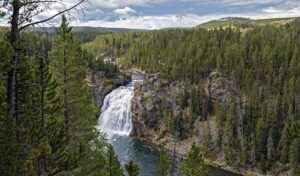
A coterie of seventy-two along with reporters and newsreel cameramen followed them to Yellowstone. Stephen Mather, first director of the National Park Service, convinced President Harding to visit three national parks in route to his ill-fated vacation in California and Alaska in June and July 1923. No president had visited Yellowstone since Theodore Roosevelt in 1903. His speech was the first to be broadcast on live radio coast to coast. Harding dedicated a monumental bronze statue to the Greek hero of music, Orpheus, at Fort McHenry Park in Baltimore on June 14, 1922. Harding created a number of national monuments, including Aztec Ruins in New Mexico, Hovenweep in Utah and Colorado, and Pipe Spring in Arizona. Legislation creating the National Park Service was signed by President Woodrow Wilson on August 25, 1916. Promoters launched a crusade for a national parks bureau in the pages of the Saturday Evening Post and the National Geographic. Western railroads favored many of the early parks by building grand hotels, where those who traveled by train could stay. The national parks had been developed by conservationists and by hunters like Roosevelt in an idealistic impulse to preserve nature, but also by businessmen in the desire to promote tourism. Taft knew Japan well from the time when her husband was governor-general of the Philippines, and she remembered the spring cherry blossoms. In 1912, First Lady Helen Herron Taft and her friend the Viscountess Chinda, wife of the Japanese ambassador, planted two Yoshino cherry trees on the banks of the Potomac River, near what was to become the Jefferson Memorial, to celebrate the gift sent by Yukio Ozaki, mayor of Tokyo, of 3,020 Japanese cherry trees to beautify the parks of Washington, D.C. Under Taft, Glacier National Park was established in 1910. In 1909 William Howard Taft, who followed Roosevelt in the presidency, proclaimed Mukuntuweap National Monument in Utah (later it became Zion National Park), and he continued to establish national monuments by presidential proclamation.

It was the first of the presidential rustic cabins, which culminated in Camp David. The Roosevelts and their children enjoyed Pine Knot, visiting several times during the Roosevelt presidency. should see.” 3Įvidence of Roosevelt’s love of the wilderness was Pine Knot, a cabin and 15 acres near Charlottesville, Virginia, that First Lady Edith Roosevelt purchased as a rural retreat, a four-hour train ride away from Washington and the White House. What you do is to keep it for your children, your children’s children, and for all who come after you, as the one great sight which every American. The ages have been at work on it, and man can only mar. Roosevelt once said of the Grand Canyon: “Leave it as it is. This is the ranch in North Dakota that Roosevelt bought as a young man and where he fell in love with the natural wilderness of the area. Another memorial to Roosevelt’s conservation efforts is Theodore Roosevelt National Park, established in 1947. This island, in the Potomac River at Washington, D.C., was reclaimed as a forest and wildlife sanctuary. In 1932 Congress authorized Theodore Roosevelt Island as a national memorial. Several Park Service sites recognize Roosevelt’s conservation efforts. Roosevelt increased natural forest lands from 43 million to 194 million acres. 2 In those same years Congress established 5 national parks, including Crater Lake in Oregon, Wind Cave in South Dakota, and Mesa Verde in Colorado. During his tenure as president Roosevelt established 150 national forests, 51 bird preserves, and 4 game preserves. In a move to preserve prehistoric Indian ruins and artifacts on public lands, he signed the Antiquities Act of 1906, using it to create eighteen national monuments by presidential proclamation, including Devils Tower in Wyoming El Morro in New Mexico and, in Arizona, Montezuma Castle, the Petrified Forest, and the Grand Canyon.

President Theodore Roosevelt saw in conservation a means of keeping the natural wealth of the United States for the public and not leaving it as it had been for the economic benefit of entrepreneurs. Following the Yellowstone precedent, Congress established national parks in the 1890s and early 1900s, including Mount Rainier (1899), Glacier (1910), and Yosemite, which was returned to the United States by California in 1890. Grant had approved the establishment of Yellowstone National Park “as a public park or pleasuring-ground for the benefit and enjoyment of the people.” 1 Yellowstone was the first “national” park.

Hayes toured California’s Yosemite in an open carriage. California’s Yosemite State Park was established in 1864, by a federal cession approved by President Abraham Lincoln, and on October 21, 1880, President Rutherford B. The national parks preceded the National Park Service, but the first great natural park was a state park.


 0 kommentar(er)
0 kommentar(er)
